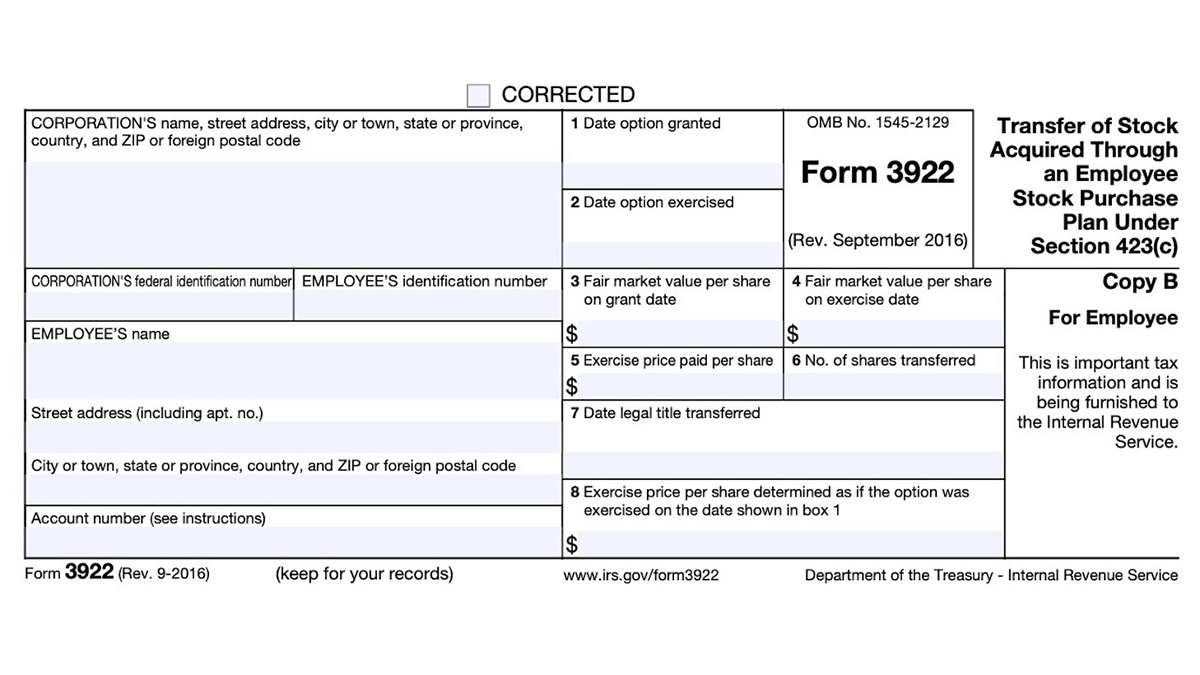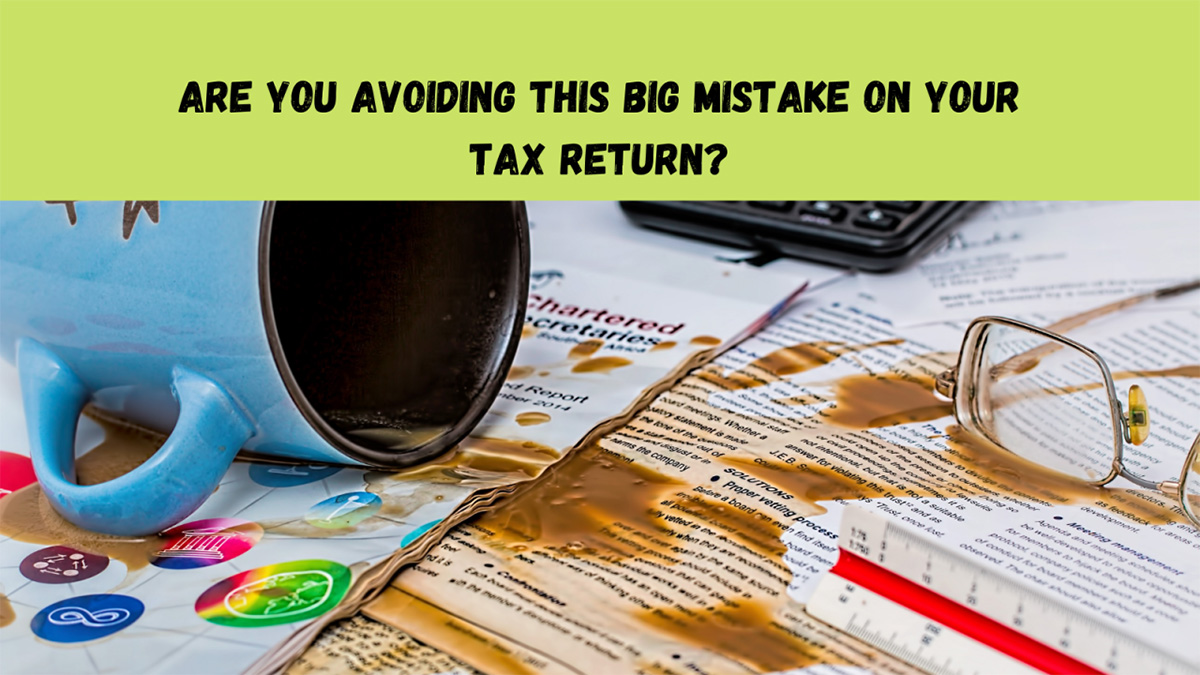

Finance
How To Report Form 3922 On A Tax Return
Published: October 29, 2023
Learn how to properly report Form 3922 on your tax return and ensure compliance with IRS regulations. Find expert advice and guidance on finance-related tax matters.
(Many of the links in this article redirect to a specific reviewed product. Your purchase of these products through affiliate links helps to generate commission for LiveWell, at no extra cost. Learn more)
Table of Contents
Introduction
Welcome to our guide on how to report Form 3922 on a tax return. Taxes can be complex and overwhelming, especially when it comes to reporting various forms and documents. Form 3922 is a critical document for individuals who have exercised incentive stock options (ISOs) through their employer. It provides important information about the cost basis and taxable income associated with the exercise of these options.
Understanding how to correctly report Form 3922 on your tax return is essential to ensure compliance with the Internal Revenue Service (IRS) regulations and to avoid any potential penalties or audits. By accurately reporting this form, you can also maximize your tax benefits and minimize your tax liability.
In this article, we will guide you through the process of reporting Form 3922 on your tax return, step by step. We will provide you with the necessary information to meet the reporting requirements and tips for ensuring accuracy. Additionally, we will highlight common mistakes to avoid and answer frequently asked questions to address any uncertainties you may have.
Reporting Form 3922 can be a complex task, but with the right knowledge and guidance, you can navigate through the process smoothly. So, let’s dive in and learn how to report Form 3922 on your tax return to ensure compliance and optimize your tax situation.
Understanding Form 3922
Before we delve into the reporting requirements, it is important to gain a thorough understanding of what Form 3922 is and why it is necessary to report it on your tax return.
Form 3922, also known as the Transfer of Stock Acquired Through an Employee Stock Purchase Plan (ESPP) under Section 423(c), is a document provided by your employer if you purchased stock through an ESPP and meet certain requirements outlined by the IRS.
This form serves two primary purposes:
- It reports specific information about the stock purchase transaction, such as the date of grant, the exercise price, the fair market value (FMV) of the stock on the exercise date, and the number of shares acquired through the exercise of the ISOs.
- It helps determine the cost basis and any potential taxable income associated with the exercise of the ISOs.
The information provided on Form 3922 is essential for accurately calculating your tax liability and determining whether you need to report any income from the exercise of ISOs on your tax return.
It’s important to note that not all stock options are eligible for reporting on Form 3922. This form specifically applies to ISOs granted under an ESPP and does not include non-qualified stock options (NQSOs) or other similar equity compensation plans.
Now that we have a basic understanding of Form 3922 and its purpose, let’s explore the specific requirements for reporting this form on your tax return.
Requirements for Reporting Form 3922 on a Tax Return
When it comes to reporting Form 3922 on your tax return, there are several key requirements that you need to be aware of to ensure compliance with IRS regulations. These requirements include:
- Receipt of Form 3922: You should have received a copy of Form 3922 from your employer if you exercised ISOs through an ESPP during the tax year. It is crucial to keep this form for your records and to accurately report the information provided on it.
- The need to Meet Filing Thresholds: You are required to report Form 3922 on your tax return if you meet the filing thresholds set by the IRS. Generally, this applies if you have any ISOs to report or if you received a refund or credit as part of the tax year’s tax-related items.
- Reporting Section 6039: The information provided on Form 3922 should be reported on Section 6039 of your tax return, specifically on Schedule D (Capital Gains and Losses) and Form 8949 (Sales and Other Dispositions of Capital Assets).
- Correctly Calculating the Cost Basis: The cost basis of the stock acquired through the exercise of ISOs should be determined accurately. This involves calculating the exercise price, the FMV of the stock on the exercise date, and any adjustments for disqualifying dispositions or adjustments provided by your employer.
- Identifying Disqualifying Dispositions: If you sold or disposed of the stock acquired through the exercise of ISOs in a disqualifying disposition, you must report this on your tax return. Disqualifying dispositions occur when you do not meet the required holding periods for favorable tax treatment.
Keep in mind that these requirements may vary based on your specific tax situation and any additional guidance provided by the IRS. It is always a good idea to consult a tax professional or refer to IRS publications for the most up-to-date information and guidance.
Now that we understand the requirements for reporting Form 3922, let’s move on to the step-by-step guide for reporting this form on your tax return.
Step-by-Step Guide to Reporting Form 3922 on a Tax Return
Reporting Form 3922 on your tax return may seem daunting at first, but with a step-by-step approach, it can be a straightforward process. Here is a guide to help you report Form 3922 accurately:
- Gather the necessary documents: Collect all the relevant documents you will need, including the copy of Form 3922 provided by your employer. Make sure you have all the information required to fill out the form correctly.
- Review the information on Form 3922: Carefully review the information provided on Form 3922, such as the grant date, exercise price, FMV, and the number of shares acquired. Verify that the information matches your records and that there are no discrepancies.
- Complete Schedule D and Form 8949: Determine whether you have any disqualifying dispositions to report. If you do, complete Schedule D and Form 8949 to report the sale or disposition of the stock acquired through the ISOs. Include the necessary information, such as the date of sale, sales price, and the cost basis of the stock.
- Calculate the cost basis: Calculate the cost basis of the stock acquired through the exercise of ISOs. Take into consideration the exercise price, FMV on the exercise date, and any adjustments or disqualifying dispositions that may affect the cost basis.
- Transfer the information to your tax return: Transfer the relevant information from Form 3922 to the appropriate sections of your tax return. Enter the necessary details on Schedule D and Form 8949, ensuring accuracy and completeness.
- Double-check for accuracy: Review your tax return to ensure all the information from Form 3922 has been entered correctly. Check for any errors or omissions, and make any necessary corrections before submitting your tax return.
- File your tax return: Once you are confident that everything is accurate and complete, file your tax return along with any additional schedules or forms that are required based on your overall tax situation.
Following these steps will help you report Form 3922 correctly on your tax return. However, it is crucial to consult a tax professional or refer to the IRS guidelines for your specific tax situation, as there may be additional considerations or requirements depending on your circumstances.
Now that you understand the step-by-step process for reporting Form 3922, let’s explore some tips to ensure accuracy in your reporting.
Tips for Accuracy
Accurate reporting of Form 3922 on your tax return is essential to ensure compliance with IRS regulations and to minimize the risk of errors or discrepancies. Here are some helpful tips to enhance the accuracy of your reporting:
- Verify the information: Double-check all the information provided on Form 3922, including dates, exercise prices, FMV, and the number of shares acquired. Compare it with your own records to ensure accuracy.
- Understand the cost basis calculation: Familiarize yourself with the calculation of the cost basis for the stock acquired through the exercise of ISOs. Be aware of any adjustments or disqualifying dispositions that may affect the cost basis calculation.
- Keep supporting documentation: Maintain detailed records and supporting documentation related to the exercise of ISOs. This includes records of the grant date, exercise date, exercise price, FMV, and any adjustments made to the cost basis. These records will serve as evidence in the event of an audit or verification by the IRS.
- Consult a tax professional: If you are unsure about any aspect of reporting Form 3922 or if your tax situation is complex, seek guidance from a qualified tax professional. They can provide personalized advice and ensure that you comply with all IRS regulations.
- Stay updated with IRS guidelines: Regularly check for updates and changes in IRS guidelines regarding reporting Form 3922. Tax laws and regulations can evolve, so it is essential to stay informed to ensure accurate reporting.
- File your tax return on time: Adhere to the tax filing deadlines set by the IRS to avoid any penalties or late filing fees. Filing your tax return on time helps maintain accurate and timely reporting of Form 3922.
By following these tips, you can enhance the accuracy of reporting Form 3922 on your tax return. Accuracy not only ensures compliance but also provides peace of mind knowing that your tax reporting is in line with IRS regulations.
Now that we have covered tips for accuracy, let’s explore some common mistakes to avoid when reporting Form 3922.
Common Mistakes to Avoid
Reporting Form 3922 on your tax return can be complex, and it’s important to be aware of common mistakes to avoid. These mistakes can lead to inaccuracies in your tax filing and may result in penalties or additional scrutiny from the IRS. Here are some common mistakes to watch out for:
- Ignoring or forgetting to report Form 3922: The most crucial mistake is failing to report Form 3922 altogether. If you received this form from your employer, it is essential to include it in your tax return. Failure to do so may trigger an IRS audit and potential penalties.
- Incorrectly calculating the cost basis: The cost basis of the stock acquired through the exercise of ISOs is a critical component of reporting Form 3922 accurately. Failing to calculate the cost basis correctly may result in reporting incorrect taxable income or capital gains on your tax return.
- Not reporting disqualifying dispositions: If you sold or disposed of stock acquired through ISOs in a disqualifying disposition, it must be reported on your tax return. Failing to do so may lead to an inaccurate tax liability calculation and potential IRS scrutiny.
- Missing filing thresholds: Neglecting to consider the filing thresholds set by the IRS for reporting Form 3922 can result in the omission of necessary reporting. Make sure to understand the thresholds and file accordingly, even if you have a minimal tax liability.
- Overlooking adjustments or adjustments: Adjustments or disqualifying dispositions provided by your employer can affect the cost basis calculation. Failing to consider these adjustments may lead to inaccuracies in reporting the cost basis and subsequent tax liability.
- Not maintaining proper documentation: Failing to keep proper records and documentation related to the exercise of ISOs can make it challenging to accurately report Form 3922. Keep detailed records of dates, prices, and other relevant information to support your tax filing.
To avoid these common mistakes, it is crucial to review the reporting requirements carefully, seek guidance if needed, and maintain accurate records. By doing so, you can ensure accurate reporting of Form 3922 and minimize any potential issues with the IRS.
Now that we have covered common mistakes to avoid, let’s move on to addressing some frequently asked questions regarding Form 3922.
Frequently Asked Questions
Here are answers to some frequently asked questions regarding Form 3922:
- What is the deadline for reporting Form 3922?
- What happens if I don’t receive Form 3922 from my employer?
- Are there any penalties for incorrect reporting of Form 3922?
- Can I amend my tax return if I made a mistake on Form 3922?
- Is Form 3922 applicable to non-qualified stock options (NQSOs)?
- Do I need to report Form 3922 if I had no income from exercising ISOs?
Often, the deadline for reporting Form 3922 is the same as the deadline for filing your tax return, which is typically April 15th of the following year. However, it is essential to check IRS guidelines for any specific deadlines or extensions that may apply to your situation.
If you exercised ISOs through an ESPP but did not receive Form 3922 from your employer, you should make a reasonable effort to obtain the necessary information to accurately report the transaction on your tax return. Contact your employer’s human resources or accounting department to request the form or gather the required information.
Inaccurate reporting of Form 3922 can lead to penalties and potential IRS scrutiny. Penalties may vary based on factors like the size of the underpayment, the period of time the underpayment remained unpaid, and whether the mistake was due to negligence or intentional disregard of the tax rules.
Yes, if you discover a mistake on your previously filed tax return, including incorrect reporting of Form 3922, you can file an amended tax return using Form 1040X. Be sure to include the corrected information and explain the changes made. However, it is crucial to file the amended return within the IRS statute of limitations.
No, Form 3922 is specifically for reporting incentive stock options (ISOs) acquired through an employee stock purchase plan (ESPP). Non-qualified stock options (NQSOs) are reported differently, and a different IRS form, such as Form 1099-B, may be applicable.
Yes, you are still required to report Form 3922 even if you did not have any income from exercising ISOs. Reporting the form allows the IRS to track the exercise of ISOs and monitor compliance with tax regulations.
These are just a few commonly asked questions about Form 3922. Remember to consult IRS guidelines or seek advice from a tax professional to address any specific questions or concerns based on your unique tax situation.
Now that we have covered the frequently asked questions, let’s wrap up this guide.
Conclusion
Reporting Form 3922 on your tax return is a crucial step in ensuring compliance with IRS regulations and accurately reporting your income from the exercise of incentive stock options (ISOs) through an employee stock purchase plan (ESPP). By following the step-by-step guide provided in this article, you can navigate the reporting process with confidence and accuracy.
Understanding Form 3922 and its requirements is key to successful reporting. Remember to gather all the necessary documents, review the information on the form, and correctly calculate the cost basis of the stock acquired through the exercise of ISOs. Be mindful of any disqualifying dispositions and ensure that you meet the filing thresholds set by the IRS.
Avoid common mistakes such as not reporting Form 3922, miscalculating the cost basis, and failing to maintain proper documentation. Stay updated with IRS guidelines and consult a tax professional if needed to ensure accurate reporting and minimize the risk of penalties or audits.
By accurately reporting Form 3922 on your tax return, you can optimize your tax benefits, minimize your tax liability, and maintain compliance with the IRS. Remember to file your tax return on time and keep a copy of all relevant documents for your records.
We hope this guide has provided you with the necessary information and guidance to confidently report Form 3922 on your tax return. Always refer to the IRS guidelines and consult a tax professional for personalized advice based on your unique tax situation.
Reporting your taxes accurately helps ensure financial well-being and peace of mind. Happy tax reporting!














